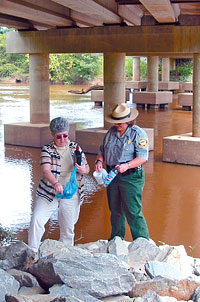Waterway clean up set for next month
By Becky Barclay
Published in News on September 13, 2004 1:57 PM
While Wayne County residents are cleaning the roadsides in Saturday's Litter Sweep, another sweep is being planned for the county.
The 2004 Big Sweep will be held Oct. 2 from 9 a.m. to 1 p.m., when residents put on their hats, gloves and boots to clean local waterways.
The purpose of the Big Sweep is to have litter-free rivers and streams and preserve the beauty and safety of one of the most valuable natural resources.

News-Argus/Becky Barclay
Barbara Byers, left, Big Sweep coordinator, and Carla Edwards, Cliffs of the Neuse park ranger, survey some of the trash that needs to be cleaned from under the Sam Casey bridge as they prepare for Big Sweep Oct. 2.
According to Barbara Byers, local Big Sweep coordinator for the past eight years, wildlife suffers when the waterways are littered with trash. Hundreds of wildlife mistake litter for food and die. They also become tangled in discarded trash and are rarely able to get free.
But it's not only the wildlife that suffers from littering. It's also a human health hazard because litter attracts disease-carrying mosquitoes and rodents. And litter contaminates the water supply.
Ms. Byers said a lot of Wayne County's youth participate in Big Sweep every year. This includes the art club at Rosewood Middle School, many of the 4-H clubs and Scouts.
"I think this is something that's needed here," said Ms. Byers. "I just walked down under the Sam Casey Bridge and saw a lot of trash. That's only one place.
"One of the most positive things is that we can clean ditches and other areas, because eventually, most of that trash makes its way down to a stream and then out into the ocean and endangers wildlife."
Ms. Byers said some of the most unusual items Big Sweep participants have found in Wayne County are a brand new pair of tennis shoes with the tags still on them, a shopping cart out in the middle of the Neuse River and 40 different kinds of sports balls. "Last year was the first year we didn't find any tires at all," she said.
There is a list of places that need to be cleaned for those who want to help this year. Or participants may pick their own place to clean. The cleanup doesn't have to be done on that day; it may be done the week prior to Big Sweep.
Ms. Byers is asking those who are participating in Big Sweep to register their projects with her by calling 731-1527. She has trash bags and data cards for those helping clean.
This year's participants will receive a coupon for a free hamburger from Burger King.
Last year, more than 192,000 volunteers picked up 3,358 tons of trash from 14,144 miles of waterways in North Carolina. In Wayne County, 283 volunteers picked up 3,340 pounds of trash from 13 miles of waterways at 16 sites.
The top 10 items found in 2003 were plastic beverage bottles, beverage bottles, cigarettes and filters, glass beverage bottles, food wrappers and containers, bags, cups and utensils, caps and lids, straws and stirrers.
The North Carolina Big Sweep began as Beach Sweep in 1987, founded by Dr. Lundie Spence of the North Carolina Sea Grant College Program. It attracted more than 1,000 volunteers who collected more than 14 tons of debris.
In 1989, it became the Big Sweep, the nation's first statewide waterway cleanup.
Since it began, Big Sweep has had more then 175,000 volunteers who have collected more than 6 million pounds of trash.
Ms. Byers gives the following tips for this year's Big Sweep volunteers to remember:
*Take a hat or visor and sunscreen to protect yourself from the sun.
*Wear old comfortable clothes. You will get dirty.
*Take a snack and a drink.
*Take some insect repellent and a pair of gloves.
*Make sure your shoes are sturdy and have closed toes. Your shoes may get wet. Do not go barefoot.
*Stay with a partner or group and be sure that children are supervised by an adult.
*Wear a life jacket if you'll be in a boat. Do not wade into the water to gather debris if the current is fast. Never enter the water unless you know its depth and are wearing a life jacket.
*Watch for snakes and spiders. Be careful of poison oak and poison ivy.
*Watch out for steep, slippery and unstable banks. If you are unsure of conditions, find a safer place or ask for assistance.
*Do not touch medical waste, chemical containers, barrels, pesticides or other dangerous items. Note their location and tell your site coordinator.
*Do not touch any animals, dead or alive. Trapped or injured animals may bite and they can carry disease. Alert your site coordinator.
